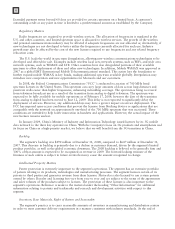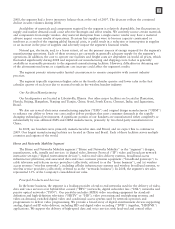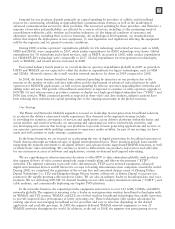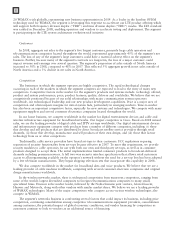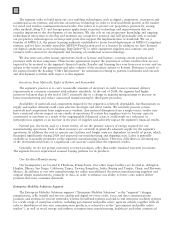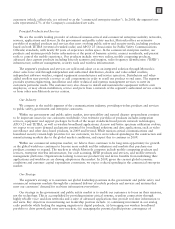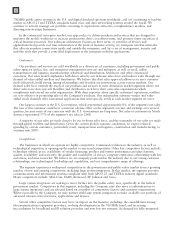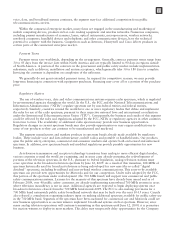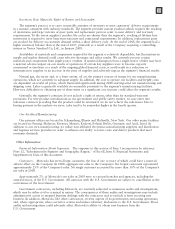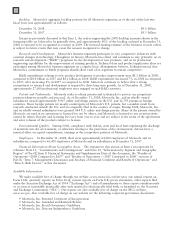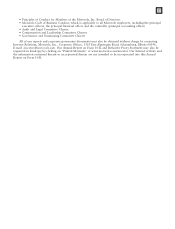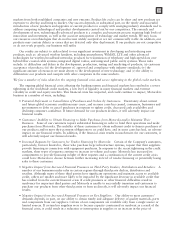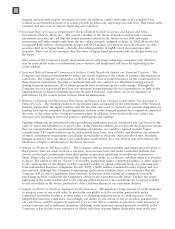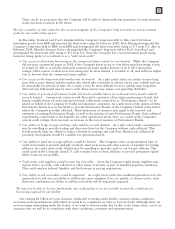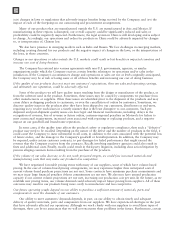Motorola 2008 Annual Report Download - page 22
Download and view the complete annual report
Please find page 22 of the 2008 Motorola annual report below. You can navigate through the pages in the report by either clicking on the pages listed below, or by using the keyword search tool below to find specific information within the annual report.
In addition to reallocating TV spectrum at 700 MHz for public safety and commercial use, in November 2008
the FCC issued a decision to open unused portions of the television spectrum below 700 MHz for unlicensed uses,
including broadband. The amount and specific location in the TV band of this “whitespace” spectrum available
varies by geographic location. Also, its use is governed by technical rules adopted to protect incumbent operations
from interference. For example, the FCC decision relies on geolocation, a technology recommended by Motorola,
to protect incumbent television stations. This decision to open the TV whitespace spectrum provides additional
potential opportunities for wireless broadband systems. The FCC decision also advised that these initial TV
whitespace rules are conservative with regard to protection of broadcast incumbents and that relaxation to provide
greater TV whitespace opportunities may be possible once additional experience is gained.
Internationally, the ITU World Radio Conference held in Geneva in November 2007 identified spectrum that
could be made available as part of a “digital dividend” as television transitions from analog to digital technology
globally. Countries around the world are studying the potential size, timing and use of this potentially available
spectrum. In November 2007, the European Commission issued a statement promoting a common European
approach to its use. The United Kingdom has already decided to redevelop spectrum as a result of the digital
transition and is making available 112 MHz of spectrum through auctions. Canada has released a consultation
requesting industry input on making additional spectrum available for public safety use in the 700 MHz band. A
number of other countries around the world have also indicated their intention to pursue the availability of digital
dividend spectrum.
In addition, some of our operations use substances regulated under various federal, state, local and
international laws governing the environment and worker health and safety, including those governing the
discharge of pollutants into the ground, air and water, the management and disposal of hazardous substances and
wastes and the cleanup of contaminated sites. Certain of our products are subject to various federal, state, local
and international laws governing chemical substances in electronic products.
Backlog
The segment’s backlog was $2.4 billion as of December 31, 2008, compared to $2.3 billion as of
December 31, 2007. The 2008 order backlog is believed to be generally firm and approximately 70% of that
amount is expected to be recognized as revenue during 2009. The forward-looking estimate of the firmness of such
orders is subject to future events that may cause the amount recognized to change.
Intellectual Property Matters
Patent protection is extremely important to the segment’s operations. The segment has an extensive U.S. and
international portfolio of patents relating to its products, systems, technologies and manufacturing processes,
including recent research developments in scanning, information collection, network communications and network
management. We have also filed additional patent applications in the U.S. Patent and Trademark Office as well as
in foreign patent offices.
The segment licenses some of its patents to third parties and this revenue is not significant. Motorola is also
licensed to use certain patents owned by others. Royalty and licensing fees vary from year to year and are subject
to the terms of the agreements and sales volumes of the products subject to licenses.
We actively participate in the development of open standards for interoperable, mission-critical digital two-
way radio systems. We have published our technology and licensed patents to signatories of the industry’s two
primary memorandums of understanding defined by the Telecommunications Industry Association (“TIA”), Project
25, and European Telecommunications Standards Institute (“ETSI”), TETRA.
Notwithstanding the expiration of certain patents and the resulting potential for increased competition for
some of our products in the future, we believe that our extensive patent portfolio will continue to provide us with
a competitive advantage. Furthermore, we believe we are not dependent upon a single patent, or a few patents.
Our success depends more upon our proprietary know-how, innovative skills, technical competence and marketing
abilities. In addition, because of changing technology, our present intention is not to rely primarily on patents or
other intellectual property rights to protect or establish our market position. However, the segment continues to
litigate against competitors to enforce its intellectual property rights in certain technologies and is currently
involved in several such lawsuits. Reference is made to the material under the heading “Other Information” for
information relating to patents, trademarks and research and development activities with respect to this segment.
14


